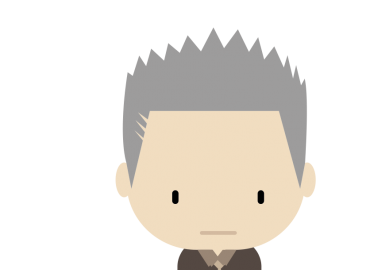Al Bumin
Expand the elements to view the case or download a printable version with the big orange button!
Mr Bumin is a 24 year old gentleman who has presented to his GP complaining of back pain.
Please take a history and carry out the relevant examination for this gentleman. You will then be asked to present your differential diagnosis and discuss aspects of this gentleman’s case.
You are a 24 year old gentleman called Alvin (Al) Bumin, who has presented to your GP with back pain.
HPC: The pain is predominately in your low back, and it started around 3 months ago. You can’t remember a particular trigger for it, and it seems to have gradually crept up on you and got worse. It is a dull ache in your low back associated with stiffness; notably, you used to be able to touch your toes and now you can barely get to your knees. You’re usually fit and active though recently have been doing less exercise, due to the pain but also due to stress at work. A week ago, you did notice that when playing squash against a colleague from work, your heel seemed quite sore. You’re not sure if the pain follows a particular pattern, but it seems to get worse when you’ve been sat in the office all day. You haven’t lost any weight, had any temperatures or night sweats, noticed any rashes or had any swelling of any joints. You’ve tried taking paracetamol which has helped a bit but not fully cleared the pain. You would rate it as 4/10. You have no stiffness/ache/symptoms in any other joints. You haven’t experienced any red eye/loss of vision/painful eye. You haven’t experienced any trauma to the back/spine.
PMH: You had asthma in your childhood, though you don’t recall having used an inhaler in over a decade.
FH: There is no history of any arthritis or joint disease in your family
DH: You take the occasional paracetamol. You don’t like taking ibuprofen as your mum (who is a pharmacist) said people with asthma should avoid drugs like it. You have no drug allergies.
SH: Non-smoker. You drink occasionally, at weekends. You work as an administrator in an accountancy firm, and haven’t missed any work due to your symptoms but you have been stressed due to mounting pressures. You like to exercise and look slim, but haven’t been able to go running or cycling recently due to stress. You occasionally play squash with colleagues after work, but your heel/ankle seems to be giving you some trouble. You live with your parents in the suburbs, and have no pets.
ICE: You think you must have twinged your back doing some activity, though you can’t think what it could be. You suspect your heel pain is due to being out of shape recently, and over-exerting yourself. You are worried that you might make it worse by exercising, which you’re desperately trying to find time to do, although you don’t want to get more out of shape. You’re hoping the GP can give you some painkillers that won’t trigger your asthma.
Please observe the student take a history from this patient. Ideally they should perform an examination of the spine in the style of REMS.
Their differential diagnosis should sound like the following:
“My differential diagnosis would firstly consist of an inflammatory cause for his back pain, given his young age, symptoms worst at rest and no obvious cause. I would suspect ankylosing spondylitis, especially as this may explain his heel pain – Achilles tendonitis can be part of the spondyloarthropathies. Secondly, this may be caused by another inflammatory process, such as psoriatic arthritis – joint symptoms precede a rash in a proportion of cases. Finally, I may suspect a mechanical cause, such as muscle strain.”
Topics for discussion: • What investigations would you undertake in the GP setting for this gentleman? • What are the extra-articular features of ankylosing spondylitis? • What are the initial treatment options for this condition? • Given his past medical history, do you think he is right to avoid NSAIDs? • What are some of the features of this condition that you may identify on imaging?





